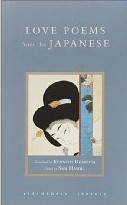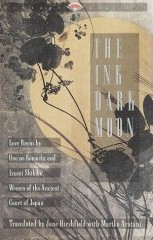- History.
The tanka developed during Japan's Heian period (794-1185 A.D.)
as a poem to recognize an occasion (especially romantic).
Woman and men composed tanka.
Often they wrote and sent the
tanka to an actual or desired lover.
Each line (or sound group) of a tanka
can be a different one image or idea,
with the resulting five lines flowing together as a greater whole.
Modern tanka
express many emotions including heartache, longing, and loss.
- Examples.

|
Modern Japanese Tanka
(edited by Makoto Ueda) is a good place to begin reading
tanka.
It it is the first collection that makes modern Japanese
tanka
available in English.
The simplicity and elegance of the
tanka
is beautifully translated and presented in this anthology,
with biographies of the poets.
|
Historically, many of the most beautiful
tanka
are the love poems by the Japanese women poets:
- Ono No Komachi (834[?]-?), who served in the start of the Heian court in present-day Kyoto, and
- Izumi Shikibu (974-1034), who wrote poetry ranging from the religious to the erotic, at
the zenith of the Heian court. (At the same time, Murasaki Shikibu
wrote and presented the world's first psychological novel,
The Tale of Genji.)
Some of the best translations of their tanka
are in
The Ink Dark Moon
translated by Jane Hirshfield with Mariko Aratani.
- Form.
-
In English, the
tanka
is usually written as five short lines.
- Traditionally in Japanese, the tanka
is five groups of sounds, each of 5 or 7 sound units.
The first and third units have 5 sound units (as in a
haiku),
while the other units have 7 sound units. This can be represented by:
-
In English, some poets consider an English syllable to be a suitable approximation to
a Japanese sound unit.
In English, we usually place each syllabic group on a separate line:
- Many writers in English use fewer syllables in a
tanka,
in recognition that English syllable are longer than Japanese sound units.
As a result, a
tanka
could use fewer syllables such as, perhaps:
-
Kozue Uzawa in her introduction to the 2006 collection
Ferris Wheel: 101 Modern and Contemporary Tanka
(translated and introduced by Kozue Uzawa and Amelia Fielden)
remarks:
|
When we translate Japanese sounds into English very accurately
(nothing added to, nothing subtracted from, the original),
the number of syllables used in the translation usually settles down around 20.
Most translations in this book, therefore, are written in about 20 English syllables.
We avoid adding words that were not written in the original just for the sake
of keeping the 31 syllables.
|
- Your Composition.
Of course, there is much more to the tanka
than the number and length of its lines. To a first approximation:
- Writes something brief, two or three lines depicting nature.
If you have written haiku
then you might find it helpful to begin with a haiku and the haiku sensibility.
- Then add the rest (usually two or three more lines) to create a new relationship, perhaps adding
information about the internal, emotional state of the poet, to show what the opening lines
signify to her. This lets the poet link nature and a feeling or emotion.
- Pay special attention to the part of the
tanka
that connect and leads
from the image of nature to the emotion.
This is where the poem turns or pivots between the physical outer world and the
non-physical inner world.
Most commonly, tanka pivot just before or after or during the third line.
- Optionally, at the pivot point, you add a third image that is related both to the preceding lines
(usually on an exterior subject)
and the lines that follow the pivot and that are written on another (usually interior) subject.
Thus two images (one outer, one inner) could be connected by a third image.
- Like a haiku, make your tanka
concise and a reflection of nature.
Both have the appearance of simplicity, but with underlying layers and resonances.
However, the tanka tends to be more lyrical, flowing, and emotive than most
haiku.
A tanka
tends to be lyrical, while a haiku can be comparatively fragmented.
A tanka
was historically written for emotional purposes, to redirect someone's
heart, whereas a Haiku is more subtle in its evocation of emotion.
Jane Reichhold in Writing and Enjoying Haiku
gives many important pointers, including:
- "It is not as if you can just glue two haiku together to get a
tanka.
Within the tanka
there is a switch of time, place, person, thing, or voice
in order to create a leap or define a new relationship."
For further information, see:
- Check list.
-
Before submitting a
tanka for possible publication, check whether it:
- Invokes a strong feeling in the reader.
- Flows like poetry, particularly when read aloud.
- Includes clear images.
- Includes some kind of shift.
- Shows immediacy and intensity of a particular moment, juxtaposing
nature (the outer world)
and human nature (the inner world)
in a new way.
- Shows freshness unobscured with excessive complexity or vagueness.
- Shows emotional honesty and authenticity.
- Recognizes its connection to the
tanka
tradition, perhaps even back to the ancestors of uta and waka,
while using language as currently spoken.
- Does not sound like an awkward translation of Japanese.
- Does, like all poems, exclude anything self-consciously "poetical" or other false notes.
- Has the tanka
form, at least in a general sense of five shortish lines, with the 1st and 3rd being shorter than
the 2nd, 4th, and 5th.
- Frames its theme.
- Avoids cliché or sentimentality.
- Progresses to a strong yet surprising final line.
- Includes a caesura (which some judges 'find to be effective').
- Includes consonance and assonance if desired.
- Includes inner rhyme if wanted; avoids or is very careful about end rhyme.
- Is indented as wished: do the last two (or three or one or four) lines (for example) need additional indentation?
- Is punctuated as wished: perhaps lightly; perhaps with a closing period and perhaps not.
Different editors and judges adopt different guidelines.
You might chose to not submit, for example, to
Ribbons (Tanka Society of America)
as they abhor punctuation, giving the
tanka an alien appearance.
In complete contrast, Jane Hirshfield
punctuates her landmark translations of Japanese
tanka in
The Ink Dark Moon
as normal poems.
- A Last Word.
Just because you start with the intention of writing a
tanka,
you do not have to
keep your poem in that form if it does not work for you.
Your attempt to write a formal poem
may help you find words that you would not have found otherwise.
And you may decide that you choose to end up with a
poem in a different form, perhaps even a
prose poem.
-
The hyakushu-uta (the 100-tanka formats)
In particular, see:
String of Beads: Complete Poems of Princess Shikishi (1993)
translated and with an introduction by Hiroaki Sato.
We have three hyakushu-uta (the 100-tanka format) written by this 12th-century Japanese princess.
Traditionally the hyakushu-uta contains six categories of tanka in six sections:
- Spring: 20 poems
- Summer: 15 poems
- Autumn: 20 poems
- Winter: 15 poems
- Love: 10 poems
- Miscellaneous: 20 poems
-
Books on Tanka

|
Modern Japanese Tanka
edited by Makoto Ueda.
This book is the first collection to make modern Japanese tanka available in English.
A delightful and comprehensive presentation of poetry that shows the development of the tanka form.
Each poet is introduced with a biography.
|

|
Writing and Enjoying Haiku: A Hands-On Guide
by Jane Reichhold.
Reichhold's many skills include a keen sense for the writing and appreciation of tanka
as well as haiku.
This book includes useful guidelines on writing tanka (as well as haiku and related forms).
|
|
|
The Ink Dark Moon,
translated by Jane Hirshfield with Mariko Aratani,
tanka of Ono No Komachi and Izumi Shikibu of the Heian court.
|
 Index of Poetry.
Index of Poetry.
 Highlights for Poetry.
Highlights for Poetry.
 Books of Poetry Form.
Books of Poetry Form.
 How to Write Poetry.
How to Write Poetry.
 Latest books read.
Latest books read.
 Haibun.
Haibun.
 Haiga.
Haiga.
 Haiku.
Haiku.
 Hay(na)ku.
Hay(na)ku.
 Rengay.
Rengay.
 Renku.
Renku.
 Tanka.
Tanka.
 Tan-renga.
Tan-renga.
 Cinquain.
Cinquain.
 Concrete.
Concrete.
 Fib.
Fib.
 Ghazal.
Ghazal.
 Lai.
Lai.
 Pantoum.
Pantoum.
 Prose poem.
Prose poem.
 Rondeau.
Rondeau.
 Rubáiyát.
Rubáiyát.
 Sestina.
Sestina.
 Skaldic verse.
Skaldic verse.
 Sonnet.
Sonnet.
 Terza rima.
Terza rima.
 Triolet.
Triolet.
 Tritina.
Tritina.
 Villanelle.
Villanelle.
 El Poema Concreto.
El Poema Concreto.
 Haiku by Bashō.
Haiku by Bashō.
 Haiku by Shiki.
Haiku by Shiki.
 Haiku by J. Zimmerman.
Haiku by J. Zimmerman.
 Tanka by J. Zimmerman.
Tanka by J. Zimmerman.
 Ueda on Tanka.
Ueda on Tanka.
 Murasaki Shikibu's The Tale of Genji.
Murasaki Shikibu's The Tale of Genji.




